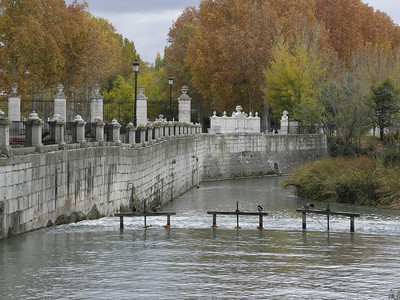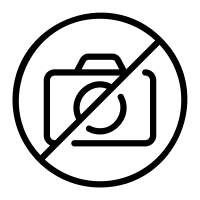Aranjuez

Aranjuez Cultural Landscape represents a varied landscape design developed over centuries.
It started out as the Royal Site of King Philip II in the 16th century, with a private country palace and extensive waterworks using the waters of the adjacent Tagus and Jarama rivers. In the 18th century, it was further enlarged with a town and roads by using geometric principles, with lines of trees as one of the most prominent characteristics.
Community Perspective: This essentially is a cleverly marketed Royal Palace (“the interior here was so ghastly it left an impression”, according to our palace expert Ian) plus its gardens (which are the best part of the site overall). Aranjuez overall is a nice and easy day trip from Madrid.


Map of Aranjuez
Community Reviews
2Flow2

Some World Heritage Sites loom large and will stun and wow people no matter who you are or where you are travelling from. I think of my time at Victoria Falls or Jerusalem and how immediately accosting those were. Aranjuez is not a site such as those, and that's okay, it's in the "majority" of sites. Aranjuez, like many of the historical cultural sites, will vary in what it offers to the visitor based on how much you effort you put into learning about it.
So what is Aranjuez?
Aranjuez was the "summer palace" location that the Spanish monarchs would retire to in the 1700s and 1800s. It has a quite massive aforementioned palace that was expanded over time, as well as a large garden/park that still exudes immense beauty, especially during the warmer months. There is a waterway that was artificially built by the monarchs so they could have boating events near the palace, and the original city center (which is removed a little bit from the palace) was originally designed to only allow members of the royal court to reside there. As a result, Aranjuez becomes a bit unique following such an "exclusive" royal history.
What type of background you come from may color how you experience Aranjuez.
Perhaps you've never been to Spain (or maybe even Europe!) before and this is one of the first handful of sites you are seeing. In that case, you're going to love Aranjuez. The size of the palace will awe you with all of its unique rooms, and you'll find the garden a delight to walk through.
On the other hand, perhaps you've seen a lot of Spain already, and have visited a ton of Spanish palaces. In this case, Aranjuez will still be nice, but it likely won't blow you away or surprise you with something significantly different than you've already seen. A lot of Spanish royal palaces were designed similarly, and the flora and fauna in Aranjuez is beautiful, but typical of what you find in much of Spain.
As for my own personal story, I loved Aranjuez! I visited it in November 2024 in my second of nine months living in Spain, and the ex-royal town made a perfect cute little daytrip from Madrid. I loved the signage inside the royal palace showing how it developed over time, and the guided tour was well worth taking. (However, I had an advantage as I can understand Spanish.) I was surprised at how great the adjacent gardens still were, even in the late Fall. based on personal experience, I recommend passing by the Visitor's Center at the beginning of your day to get a map of everything available to do. I only learned about the history of Aranjuez while on the site, but I can definitely see how much more I would have been able to get out of it if I had time to read up on some of its history beforehand.
Alikander99

Well, after a decade or so I've finally gone back to Aranjuez! here are my thoughts.
First off I think it's interesting noting that aranjuez was proposed fairly late among the Spanish sites and as a cultural landscape.
As many people have pointed out the actual highlight of the site are the gardens.
The palace is indeed kinda ghastly. The rooms were renovated in the 19th century when Spain, and particularly the crown, were in full crisis. The result is some interior design I wouldn't wish on my worst enemy. You can actually skip it tbh.
The city itself is rather surprising, in the sense that I have no idea why Unesco actually allowed its inscription. A bit of context: Spanish royal sites were thought of as a retirement sites for the monarchs, so they had no population other than the people in charge of the palace and gardens. This changed with Charles III which built up towns associated to each royal site. Spain has for a long time tried to get Unesco to extend the site of El escurial to include the city of San Lorenzo, which was built during this period. Unesco "wasn't thrilled with the idea" . So imagine my surprise when I went back to aranjuez and found out that at large its city centre is in a comparable state. I mean the city and, particularly its plan, beautifully illustrates enlightened ideals of urban planning, but that's hardly unique in Europe.
The actual star of the show as I pointed out before is the gardens, which imo could've included in the list alone, as superb examples of European royal gardens dating from the 16th to the 18th century.
The sheer size of the trees is thoroughly impressive. The London plane trees rise to 50m. there's also a huge pecan tree, and some increadible ahuehuetes. In fact, this park shines through its variety of centenary northamerican trees. They adapted very well to the climate of aranjuez and have grown to inmense sizes.
I wanted to take a second to zoom on the London plane, because it's a particularly interesting example. The tree in question is a hybrid between the western and Eastern plane trees, one found in northamerica and the other in central Asia. Its origins are debated but it's thought the hybridization probably happened in Spain or Southern France. And this kinda showcases the preeminent role Spain played in the introduction of American species into Europe. It's a part of history that's hard to represent in the list, as it was done before the rise of botany as a science and few Spanish gardens have survived the tellings of time (aranjuez might be the best, and no tree is actually older than 300 years). Anyway, the London plane tree has become one of the most common urban trees in the world, so having a site like aranjuez show the royal standing of the tree in the 18th century is kinda interesting, though alas the hybridization happened a few centuries earlier.
All in all I think the gardens of aranjuez beautifully complement the site of El escurial and give you a rough idea of what the spanish monarchs searched for in a royal site. The only thing missing are the hunting grounds.
As a final anecdote, I helped some townsfolk recollect nuts from a 200 year old pecan tree. Kind of nuts tbh
Hubert

'Die schönen Tage in Aranjuez sind nun zu Ende.' The drama Don Carlos by Friedrich Schiller starts with these words. I am not sure whether Schiller is historically correct when describing the reign of Philip II in his play. Correct is that Philip II declared Aranjuez a 'Real Sitio' in 1560, and that he commissioned the construction of the Palacio Real in the same year. My impression was also that the best days for Aranjuez are gone when I visited the site in May 2019. But not because the palace and gardens were in bad condition (on the contrary, everything was nice and well maintained). It was rather because the area around the palace was almost deserted on that weekday morning.
Castles and palaces are not my favourite world heritage sites. But there are a few exceptions on the list where I was pleasantly surprised. Aranjuez, however, was not one of them. The interiors are more or less the same sequence of rooms as in other European palaces, and similarly boring. Only two rooms are exceptional: the Porcelain Room, which is entirely covered with porcelain reliefs, and the room with 200 small Chinese paintings on rice paper, depicting rural life right next to torture scenes.
The Palacio Real impresses mainly by its size. In the 18th century two side wings were added and the whole complex was converted into a Baroque palace. My photo is the view of the palace from the south, from the Plaza de Parejas. On the right is the Casa de Oficios y Caballeros, an auxiliary building of the palace, nice with porticoes all around.
The Aranjuez Cultural Landscape comprises extensive parks and ornamental gardens around the palace. And that was the best part of my visit. Apparently, the Spanish monarchs had a fondness for water features. Between the tall trees are numerous stone and marble fountains with scenes from Greek mythology, for example one with Bacchus sitting on a barrel. You can find this and many other fountains in the Jardin de la Isla. The island was created when an artificial branch of the Tagus River was channelled directly past the palace. It is the most interesting of the gardens. However, I did not see anything in Aranjuez that I had not already seen elsewhere.
The city centre of Aranjuez is also part of the World Heritage Site. It is a planned city built in the middle of the 18th century. Before then, the right to live in Aranjuez was restricted to members of the royal court. The city map has a symmetrical layout like a chessboard, but apart from that there is nothing remarkable. Walking through the streets, I did not have the feeling of visiting a world heritage town.
All in all, Aranjuez was the least exciting WHS on my trip through central Spain.
Jay T

I love gardens, so I was rather excited to choose Aranjuez Cultural Landscape as the first central Iberian World Heritage Site to visit after I arrived in Madrid for a long weekend last May. In truth, the gardens were not as impressive as others I have visited, but I did appreciate the laidback atmosphere of this suburb that began as a royal estate in the 16th century. After arriving in town, I started my tour indoors with the palace, so as to avoid a passing rain shower. The palace had many fine rooms, but since I came to Aranjuez to view the gardens, as soon as the skies brightened I was back outside. The gardens next to the palace were beautiful, however I was slightly let down by the Island Garden, which was not as well upkept as I thought it might be. I did find the water canals within the garden curious, since they reminded me of those irrigating Al Ain Oasis in UAE. It was the weir on the Tagus next to the palace that I found most fascinating, though (as noted by other reviewers). After getting a quick lunch, I strolled around the Prince's Garden, which was far more relaxing to me. I loved walking on the pathways that bordered the Tagus River, and took time to rest and read on a bench overlooking a Chinese garden further inside the park. Aranjuez made for a pleasant introduction to central Spain, and was definitely worth touring before visiting the Royal Palace of Madrid, whose residence and gardens I was more impressed with when I visited later that trip.
Logistics: Aranjuez is about an hour away from Madrid and can be reached regularly by commuter train; the rail station in Aranjuez is a few blocks from the palace and the center of town.
Frederik Dawson

When I looked at the list of all World Heritage Sites around Madrid, Aranjuez was the least interesting site in my initial opinion; however, after visited the place, it became the second least interesting site since Alcala de Hanares won the position. Since I already saw the Royal Palace in Madrid twice including its grand royal park couple of month ago, I was not happy to have a trip just to see another Spanish royal palace, so pairing it with Cuenca was a good idea.
From Madrid I drove to Aranjuez, the city was quite lovely with many greens and fine houses, some kind of prosperous neighborhood, but when I reach city center, the view of ideal royal city welcomed me with grand scale, Grand palace on the right, French landscape gardens on the left and large square with beautiful San Antonio de Padua Church at the far end in the middle. I drove into a small alley next to palace complex, the buildings, pavement, trees were all stately and beautiful design, however those large open spaces in front of the church and next to the palace with few people around made the city a bit desert and lifeless and the area in front of the palace were shockingly rundown with shabby gardens and abandoned and ruined buildings. I toured the interior of the Aranjuez Palace, as other reviews mentioned, certain rooms especially the Moorish room and porcelain room were quite stunning and the display of royal gowns of Spanish queens and princesses for the coronation and weddings were really impressive. After the palace I visited the royal garden, I really enjoyed the lovely cascade of the river despite of some maintenance works obscured the view. The garden overall was fine but in my opinion a bit shabby luckily, I found a group of peacocks which saved the grace of this royal garden. I planned to visit other nearby UNESCO listed royal palaces and gardens, but after saw Aranjuez Palace, I already lost my appetite, so I decided to end my time in Aranjuez and continued to Cuenca.
All in all, I did not find any special with this World Heritage Site, the site was quite typical in term of European royal palace which tried to imitate Versailles. I also found that the gardens which should be the main attribute of the cultural landscape status was quite disappointing, although its shabbiness maybe Spanish garden characteristic as I saw similar situation at other parks in Madrid few days later. The only thing I found interesting was the river management by small dam and cascade at the entrance of the royal garden behind the palace, which was quite impressive, but maybe not enough to win my heart for its Outstanding Universal Value.
Kyle Magnuson
California - United States of America - 02-Aug-18 -

Previous reviews left me not expecting much from Aranjuez. However, when the sky is perfectly blue, the gardens are a lush green, and my only alternative was to join my wife shopping? Aranjuez turned out to be a delightful couple hours! Originally, I did not even include this WHS in my itinerary, since Segovia and El Escorial were my primary focus. Nevertheless, the train was simple, affordable, and the weather was superb (though hot).
I spent most of my time exploring the gardens, which really are quite extensive. There are so many small treasures to be found, from playful fountains, to an aviary, and even a "Chinese" pond. Overall, I am pleased I made the trip.
The cultural landscape pull of this world heritage site makes it unique enough. To summarize, the water landscape (rivers, ponds, dams, ditches), the agricultural landscape (orchards and nurseries, stock-breeding farms, meadows), and the landscape for leisure (ornamental gardens) all make up a rich component to Aranjuez that is best appreciated in beautiful weather.
Read more from Kyle Magnuson here.
Klaus Freisinger

My expectations for Aranjuez were not too high - another royal palace close to a big capital -, but it's very easy to reach by commuter rail from Madrid, and the palace was actually quite interesting and well-presented (especially the Porcelain Room). I then went for a walk through the surrounding parks along the Tejo River, which feature many different fountains. It was an enjoyable half-day excursion, but as mentioned in other reviews, the site does not add a lot of new value to the WH list, as evidenced by the fact that Spain had to use the trick/work-around with the cultural landscape to get this site inscribed.
Clyde

I visited this WHS in June 2015. This is one of many other WHS made up of gardens and palaces and it certainly isn't one of Europe's best. It's location helps it a great deal as it is a pleasant half day trip from Madrid or Toledo. However, I very much prefered the Escurial's interior although much more crowded. The highlights of my visit were the Island Garden and the Prince's Garden. That said, I felt that they offered no real OUV but more of a pleasant rest in the shade in what should be considered more of a national heritage site.
Ian Cade

Strapping on my camera and backpack I did my duty and after a short hop on the commuter train from Madrid I landed at yet another European Royal Palace complex.
First stop the palace; fortunately I was able to whizz around in about 20 minutes. There are so many palaces like this on the list it is tough to find things that differentiate them, fortunately the interior here was so ghastly it left an impression. The Arabian Room did a fantastic job of mimicking the heights of mudejar design and then ruining it by colouring them in like an 8 year old and the Porcelain room was so horrifically over the top you couldn’t help but be impressed. The whole time I was walking around I kept on being reminded of the taste of Hyacinth Bucket (sorry that may be a slightly niche reference).
Happy to escape the interior I ventured to the gardens, and I must admit I was pretty impressed. The Island Garden was actually a really pleasant place to wander around. The carpet of autumn leaves did add to the joy of strolling around, crunching from one little fountain to the next. In fact I would say it was one of the nicest palace gardens I have been to.
The advisory body report states that the historic centre of the town may “well have been considered for World Heritage status in its own right”. I think that is a little generous, I would probably award it the accolade of “third most interesting terminus of Madrid’s commuter trains (of those that I have so far visited, of which there are currently 3)”. It was pleasant enough but rather lacking in life, though I did enjoy watching two priests play football on one of the squares.
Despite my slightly disparaging remarks Aranjuez was actually a nice break from Madrid, the regular trains made it an easy hop from the tapas bars and galleries of the Spanish capital and the planned gardens were actually some of the nicest I have visited. I would put it as the lowest priority of all the sites around Madrid, though if you want a quiet half day strolling around some lovely gardens then join the madrileños in heading to Aranjuez.
[Site 4: Experience 4]
Els Slots

The AB evaluation of Aranjuez comes with a warning: we already have allowed 8 European Royal Palaces and their gardens on the List, this should be sufficient! The Spanish however were clever enough to propose this site as a Cultural Landscape, where the palace comes in as a side note. I found the nomination file very impressive; it does a good job of explaining the history of the manmade landscape, where the use of irrigation and dams has turned a swamp into a green oasis. It also emphasizes the importance of the parks for botany, as Philip II was an early collector of American and Asian tree species.
Except for a minor round around Aranjuez town to look for a restaurant (where I landed at the recommended La Venta for a 10 EUR 3-course Menu del Dia), I limited my visit to the palace and its gardens. I started with a stroll through the Island Garden, which is decorated with many objects including a number of statues of ancient gods. This is also where the waterworks can be seen, these include dams, canals, and bridges. And it displays the tree-lined paths that characterize Aranjuez.
Suddenly it started to rain a little, so I decided to check out the interior of the palace too. Whenever I visit palaces these days, Ian Cade's quote "palaces bore me rigid" directly comes to my mind. And yes, I too have shuffled from one boring room to the other in many palaces around the world. But I had some good experiences too lately, for example in Fontainebleau. I was lucky again now, as I was about the only visitor around. I paid for the audioguide, where the talks were informative and not too long. The number of rooms that it includes also is not too overwhelming. Among them are 3 that really stand out: the yellow rococo Grand Dining Hall, the Arabian Room and the unbelievable Porcelain Room where porcelain objects have been nailed to all walls.
On my final morning in Aranjuez, I visited the biggest garden, the Prince's Garden. This felt much more like a city park to me. It is very large and is used by joggers and local elderly going for a walk. Its strongest point is the high number of different tree species. It has less ornamentation than the Island Garden. The park ends at the Casa del Labrador, a small neoclassical palace that is also used by the Spanish royals.
Philip T.K.

I visited the royal palace at Aranjuez on my first day in Spain after an overnight flight from Montreal to Madrid. It was my first WHS in Europe. The train ride from Madrid to Aranjuez was less than an hour and it makes a perfect half-day trip from Madrid. The palace has many rooms; the one that stands out the most in my memory is the Alhambra-inspired one. Unfortunately, no photos are allowed inside. However, they are allowed at the gorgeous garden nearby. The palace is no comparison to similar sites I visited later on my trip such as El Escorial but it's worth an afternoon nonetheless. I would suggest visiting this site first before the other WHS near Madrid in order to evade disappointment.
Community Rating
- : Inigo Cia Thomas Harold Watson
- : George Gdanski
- : Zhenjun Liu IgnacioM Don Irwin 2Flow2 Shoaibmnagi Mo-han Je Laurine Can SARICA Xiquinho Silva
- : Alexander Lehmann Els Slots Philipp Peterer Christoph Dorejd Juropa Tarquinio_Superbo Chenboada J. Stevens Ovalarezo Bruno_Pires M. Huineman de la Cuadra
- : Philipp Leu Chessjsr Christravelblog Csaba Nováczky Ivan Rucek David Berlanda Craig Harder Aspasia Michael anak Kenyalang Javier Cody Ayers FK Kyle Magnuson Adolfo Martina Rúčková
- : Szucs Tamas Randi Thomsen Wojciech Fedoruk Peter Lööv Shandos Cleaver Frederik Dawson Daniel C-Hazard Dwight Zehuan Xiao Carlos Sotelo Klaus Freisinger Aleserre Aidan Coohill Alikander99 Antonio J. Viaje al Patrimonio Napalm
- : Svein Elias Zoë Sheng Alexander Parsons Jean Lecaillon Bossc CugelVance Jay T Ian Cade Felicité Mohboh AS Aitia
- : Solivagant Nan Clyde Hubert Walter Sachin Argo João Aender
- : Mike
- : Stanislaw Warwas Stanimir
Site Info
- Full Name
- Aranjuez Cultural Landscape
- Unesco ID
- 1044
- Country
- Spain
- Inscribed
- 2001
- Type
- Cultural
- Criteria
-
2 4
- Categories
- Cultural Landscape - Clearly defined
- Link
- By ID
Site History
2001 Inscribed
Site Links
Connections
The site has 31 connections
Art and Architecture
Constructions
Geography
History
Human Activity
Individual People
Religion and Belief
Science and Technology
Timeline
Trivia
Visiting conditions
WHS Hotspots
WHS on Other Lists
Visitors
260 Community Members have visited.
The Plaque
 (photo by Clyde)
(photo by Clyde)